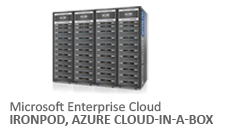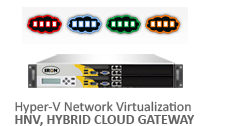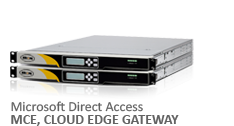Microsoft Windows Server 2012 Storage Features

Windows Server 2012 provides you a rich set of features that will help you maximize the returns from your storage investments. Read more about some of the key storage features in Windows Server 2012.
Key Features
Storage Spaces
Storage Spaces provides a new class of sophisticated virtualization enhancements to the storage stack that you can use to pool multiple physical hard disk units together and provide feature-rich, highly resilient, and reliable storage arrays to your workloads.
You can use Storage Spaces to create storage pools, which are virtualized administration units that are aggregates of physical disk units. With these storage pools, you can enable storage aggregation, elastic capacity expansion, and delegated administration. You can also create virtual disks with associated attributes that include a desired level of resiliency, thin or fixed provisioning, and automatic or controlled allocation on diverse storage media.
Offloaded Data Transfers
Offloaded Data Transfers (ODX) gives you the ability to leverage your investments in external storage arrays to offload data transfers from the server to those devices. While traditional transfers require data to route through servers, ODX bypasses this with a token-based mechanism for reading and writing data within or between intelligent storage arrays and frees up your network and CPU load.
SMB 3.0 Support for Server Workloads
With enhancements to the server message block (SMB) protocol, Windows Server 2012 helps you to deploy Hyper-V virtual machines and SQL databases on SMB file shares. The Windows Server 2012 client and server are optimized for small random read/write I/O to increase performance for common server application workloads. This capability, in addition to SMB transparent failover and Clustered Share Volume enhancements, provides a reliable, cost-effective solution for your server workloads.
File System Enhancements
Windows Server 2012 introduces a new file system, called Resilient File System (ReFS). ReFS is built for the future with significant investments that improve data integrity, availability, and scalability. Additionally, the NTFS file system has been enhanced to maintain data integrity when using cost-effective industry-standard SATA drives, provide online corruption scanning and repair capabilities that reduce the need to take volumes offline, and to provide significant improvements to Chkdsk that enable the identification and isolation of problems with specific files. This ensures that parts of the volumes are brought offline only for a matter of seconds as opposed to hours or days.
Storage Management
To help tie all these storage capabilities together and simplify the management of your increasingly complex storage environment, Windows Server 2012 introduces a new, unified interface that uses Windows Management Instrumentation (WMI) for comprehensive management of physical and virtual storage, including third-party external storage subsystems.
The unified interface enables the use of WMI to provide a rich experience to IT pros via Windows PowerShell scripting, thereby providing a diverse set of solutions. It also enables management applications to use a single Windows API to manage different storage types by using a storage management provider or standards-based protocols such as Storage Management Initiative Specification. In addition, you can use the new File and Storage Services dashboard to manage storage across your entire datacenter from within Server Manager.
Feature Updates- Windows Storage Server 2012 R2
With the 2012 R2 releases of Windows Server and System Center Microsoft made some great enhancements to Storage Spaces, Scale-Out File Server, SMB, Hyper-V and System Center.
Feature Enhancement:
- Flexible resiliency options: In Windows Server 2012 you could create a Mirror Spaces with a two-way or three-way mirror, a Parity Space with a single parity and a Simple Space with no data resiliency. New in R2 parity spaces can now be used in clustered pools and there is also a new dual parity option.
- Enhanced Rebuilding:Speed of rebuilding of failed disks is enhanced.
- Data Deduplication: Data Deduplication was already included in Windows Server 2012 but it is enhanced in Windows Server 2012 R2, and allows you to use it together with Cluster Shared Volumes (CSV) and supports VDI virtual machines.
- Read-Cache: Windows Server CSV Cache offers you Memory based Read-Cache
- Improved performance of SMB Direct (SMB over RDMA): With SMB Multichannel, SMB detects whether a network adapter has the RDMA capability, and then creates multiple RDMA connections for that single session (two per interface). This allows SMB to use the high throughput, low latency, and low CPU utilization offered by RDMA-capable network adapters. It also offers fault tolerance if you are using multiple RDMA interfaces. Improves performance for small I/O workloads by increasing efficiency when hosting workloads with small I/Os (such as an online transaction processing (OLTP) database in a virtual machine). These improvements are evident when using higher speed network interfaces, such as 40 Gbps Ethernet and 56 Gbps InfiniBand.
- SMB event messages:SMB events now contain more detailed and helpful information. This makes troubleshooting easier and reduces the need to capture network traces or enable more detailed diagnostic event logging. By default, the most relevant event channels are turned on, so you instantly capture all of the essential information. In addition, some events now include details on configuration and troubleshooting solutions.
- Failover Clustering:Improvements in the areas of virtual machine availability, Cluster Shared Volumes (CSV), dynamic cluster quorums, cluster node health detection, deployment, updating and monitoring.
- DFS Replication (DFS-R): Increases in scalability, ability to do database cloning and corruption recovery, Windows PowerShell modules for DFS-R, a new WMI provider, faster replication on high bandwidth connections, and recovery tools for conflicts.
New Features:
- Storage Auto-Tiering : Windows Server 2012 R2 allows you to use SSD and HDD and automatically moves “hot-data” from SAS disks to fast SSD storage.
- Write-Back Cache: This feature allows data to be written to SSD first and moves later to the slower SAS tier. Management – Management of Hyper-V and Scale-Out File Servers as well as Storage Spaces right in System Center
- Management: Management of Hyper-V and Scale-Out File Servers as well as Storage Spaces right in System Center 2012 R2 Virtual Machine Manager.
- Deployment: Deploy new Scale-Out File Server Clusters with and without Storage Spaces directly from System Center 2012 R2 Virtual Machine Manager via Bare-Metal Deployment.
- Automatic Rebalancing of Scale-Out File Server clients: This functionality improves scalability and manageability for Scale-Out File Servers. SMB client connections are tracked per file share (instead of per server), and clients are then redirected to the cluster node with the best access to the volume used by the file share. This improves efficiency by reducing redirection traffic between file server nodes. Clients are redirected following an initial connection and when cluster storage is reconfigured.
- Shared VHDX files: Simplifies the creation of guest clusters by using shared VHDX files for shared storage inside the virtual machines.. This also masks the storage for customers if you are a service provider.
- Hyper-V Live Migration over SMB: Enables you to perform a live migration of virtual machines by using SMB 3.0 as a transport. This allows you to take advantage of key SMB features, such as SMB Direct and SMB Multichannel, by providing high speed migration with low CPU utilization.
- SMB bandwidth management: Enables you to configure SMB bandwidth limits to control different SMB traffic types. There are three SMB traffic types: default, live migration, and virtual machine.
- Multiple SMB: instances on a Scale-Out File Server – Provides an additional instance on each cluster node in Scale-Out File Servers specifically for CSV traffic. A default instance can handle incoming traffic from SMB clients that are accessing regular file shares, while another instance only handles inter-node CSV traffic.
- Work Folders: a new feature that facilitates the BYOD (bring-your-own-device) trend by enabling users to access work files from their personal computers and devices. Organizations retain centralized control over that data and can specify device policies such as encryption and lock screen password.









